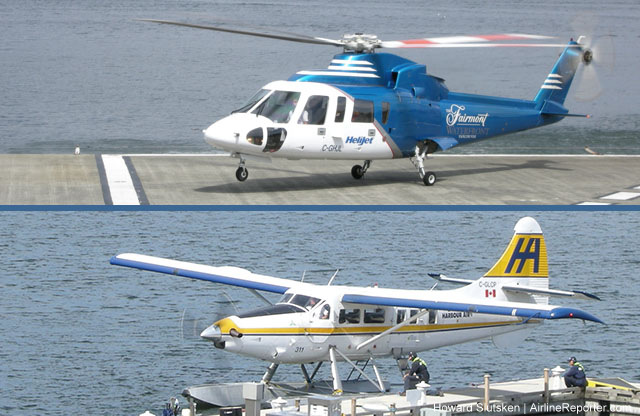
Helijet Sikorsky S-76 & Harbour Air DHC-3 Turbine Otter
In the early 2000s I lived in beautiful Victoria, British Columbia, about as far west in Canada as you can be without falling into the Pacific Ocean. Victoria is at the most southern tip of 460 km (290 mile) long Vancouver Island, about even with Whidbey Island, Washington. Business would take me to downtown Vancouver regularly, a straight-line distance of about 110 km (70 miles). I could drive to the ferry terminal, wait, have a nice 90 minute ferry ride, then drive in traffic to downtown Vancouver. Total trip time? 3 hours, if traffic was light. Cost? About CA$70 each way. But I could also fly harbour to harbour in about 30 minutes. As a fellow AvGeek, which one do you think I enjoyed more??
There are 2 regular airline services flying between Victoria’s and Vancouver’s harbours. Both harbours are Transport Canada certified airports, with designated water ’œrunways’. You can fly fixed-wing on Harbour Air’s 14 passenger DeHavilland Canada DHC-3 Turbine Otters or 18-seat DHC-6 Twin Otters. Or you can take a helicopter – Helijet flies 12-seat, twin-engine, Sikorsky S-76s or 4-seat Bell 206L LongRangers. Which way to go? Let’s have a look at the two airlines.

Twin Otter – Series 400 on Amphibious Floats – check out the prop vortices!
Photo: Viking Air
You know what it’s like. You look in the closet, and see that well-worn leather jacket hanging there. It keeps you warm, you know it makes you look good, but it’s showing its age. The zipper might not work so well or a pocket lining might be a bit torn. You take care of it – it’s been repaired and cleaned many times. You’ve been thinking about getting a new one, but you can’t find one anywhere, because styles and materials have changed over the years. So you keep wearing it and wearing it and wearing it.
AvGeeks know that there are a few airplanes that are like that. Love ’˜em, can’t replace ’˜em! The venerable Douglas DC-3 is one. Never duplicated, and still flying with airlines like Buffalo Airways of ’œIce Pilots NWT’ fame, even though the last DC-3 rolled off the assembly line in 1947.
The deHavilland Canada DHC-6 Twin Otter is another. Amazing Short Take Off and Landing (STOL) capability, twin bulletproof Pratt & Whitney Canada turboprops, decent cruise speed, has 19 seats, or it can carry a whack of cargo. The final Series 300 ’œTwotter’ was produced in 1988 at the DHC plant in Toronto. Over 800 Twin Otters were produced, and 600 are still flying on land, sea and snow, from pole-to-pole and on every continent. An amazing statistic. Operators said that the only thing that can replace an old Twin Otter is a NEW Twin Otter. But new ones weren’t available, so operators kept flying them and flying them and flying them.

